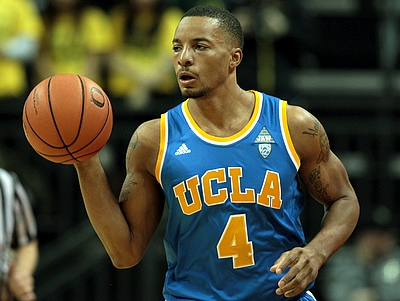#6) Norman Powell, 6'4, Shooting Guard, 23.1 years old, Raptors, UCLA
EWA: 1.1
PER: 28.2
TS%: 59.4%
19.8 PTS, 4.4 REB, 2.4 AST, 1.0 STL, 12-26 3P, 29-35 FT%, 42.6 FG%
Norman Powell followed up his solid rookie season with another strong showing at the Las Vegas Summer League. The #46 pick in 2015, who found himself splitting time between the NBA and D-League to start the season, earned the trust of the coaching staff in Toronto and ended up playing some valuable minutes during their playoff run to the Eastern Conference Finals.
Powell is a slashing guard with elite physical tools (including a 6'11 wingspan), who is at his best getting downhill or out in transition, using his strength and athletic ability to finish around the rim. He was not a strong 3-point shooter in college, but he has shown a great deal of improvement in that aspect of his game, shooting 38% on 114 attempts last season, and following that up with a 12-26 performance in Las Vegas. Powell has ball-handling and play making abilities, but he is more of a scoring guard who is looking to get into the paint and score, sometimes leading to some wild shots when the defense has collapsed around him. He has all the physical tools to guard multiple guard positions at the NBA level, and he will continue to grasp a better sense of how to be effective and use his tools on that end of the floor. Powell was acquired by the Raptors in a draft day trade for Greivis Vasquez (which also netted a 2017 first round pick), and is looking like a major steal considering where he was drafted.
Articles
Norman Powell Workout Video and Interview
Jun 22, 2015, 08:11 am
An interview with UCLA's Norman Powell, featuring footage from his pre-draft workouts in Los Angeles.
(Video may not load with Internet Explorer. Use Chrome or Firefox)
More Pre-Draft Interviews/Workout Videos
-Alan Williams Workout Video and Interview
-T.J. McConnell Workout Video and Interview
-Kevon Looney Workout Video and Interview
-Christian Wood Workout Video and Interview
[url=-Larry Nance Workout Video and Interview
-Kristaps Porzingis Workout Video
-ASM Workout Outtakes: Kristaps Porzingis Dunks/Jumpers/Post-Moves
-Kristaps Porzingis Interview
-Emmanuel Mudiay Workout Video and Interview
-Josh Richardson Workout Video and Interview
-Dakari Johnson Workout Video and Interview
-Devin Booker Workout and Interview
-Jonathan Holmes Workout Video and Interview
-Alpha Kaba Workout and Interview
-Willie Cauley-Stein Workout
-Karl Towns Workout
-D'Angelo Russell Workout
-D'Angelo Russell Interview
-CAA Workout Outtakes: Towns/Cauley-Stein Dunks from LA
-CAA Workout Outtakes: Russell/Towns/Cauley-Stein Jumpers
-Justin Anderson Workout Video and Interview
-Cliff Alexander Workout Video and Interview
-R.J. Hunter Workout Video and Interview
-Bobby Portis Workout Video and Interview
-Sam Dekker Workout Video and Interview
-Kelly Oubre Workout Video and Interview
-Stanley Johnson Workout Video and Interview
-Terry Rozier Workout Video and Interview
-Michael Qualls Workout Video and Interview
-Rondae Hollis-Jefferson Workout Video and Interview
-Rashad Vaughn Workout Video and Interview
-Andrew Harrison Workout Video
-J.P. Tokoto Workout Video
-Jarell Martin Workout Video
-D'Angelo Russell Interview
-Quinn Cook Interview
-Frank Kaminsky Workout Video
-Robert Upshaw Workout Video
-Rakeem Christmasn Workout Video
-Myles Turner Workout Video
-Stanley Johnson Interview
-Kelly Oubre Interview
-Frank Kaminsky Interview
-Satnam Singh Interview
-Satnam Singh Workout Video
-Alan Williams Interview
-Aaron White Interview
-T.J. McConnell Interview
-Chasson Randle Workout Video
-Chris Walker Interview
-Chris Walker Workout Video
-Cameron Payne Workout Video
-Cameron Payne Interview
(Video may not load with Internet Explorer. Use Chrome or Firefox)
More Pre-Draft Interviews/Workout Videos
-Alan Williams Workout Video and Interview
-T.J. McConnell Workout Video and Interview
-Kevon Looney Workout Video and Interview
-Christian Wood Workout Video and Interview
[url=-Larry Nance Workout Video and Interview
-Kristaps Porzingis Workout Video
-ASM Workout Outtakes: Kristaps Porzingis Dunks/Jumpers/Post-Moves
-Kristaps Porzingis Interview
-Emmanuel Mudiay Workout Video and Interview
-Josh Richardson Workout Video and Interview
-Dakari Johnson Workout Video and Interview
-Devin Booker Workout and Interview
-Jonathan Holmes Workout Video and Interview
-Alpha Kaba Workout and Interview
-Willie Cauley-Stein Workout
-Karl Towns Workout
-D'Angelo Russell Workout
-D'Angelo Russell Interview
-CAA Workout Outtakes: Towns/Cauley-Stein Dunks from LA
-CAA Workout Outtakes: Russell/Towns/Cauley-Stein Jumpers
-Justin Anderson Workout Video and Interview
-Cliff Alexander Workout Video and Interview
-R.J. Hunter Workout Video and Interview
-Bobby Portis Workout Video and Interview
-Sam Dekker Workout Video and Interview
-Kelly Oubre Workout Video and Interview
-Stanley Johnson Workout Video and Interview
-Terry Rozier Workout Video and Interview
-Michael Qualls Workout Video and Interview
-Rondae Hollis-Jefferson Workout Video and Interview
-Rashad Vaughn Workout Video and Interview
-Andrew Harrison Workout Video
-J.P. Tokoto Workout Video
-Jarell Martin Workout Video
-D'Angelo Russell Interview
-Quinn Cook Interview
-Frank Kaminsky Workout Video
-Robert Upshaw Workout Video
-Rakeem Christmasn Workout Video
-Myles Turner Workout Video
-Stanley Johnson Interview
-Kelly Oubre Interview
-Frank Kaminsky Interview
-Satnam Singh Interview
-Satnam Singh Workout Video
-Alan Williams Interview
-Aaron White Interview
-T.J. McConnell Interview
-Chasson Randle Workout Video
-Chris Walker Interview
-Chris Walker Workout Video
-Cameron Payne Workout Video
-Cameron Payne Interview
Norman Powell Updated NBA Draft Scouting Report
Jun 05, 2015, 08:46 am
Matt Williams
A tough, athletic shooting guard from San Diego, Norman Powell's solid four year career at UCLA came to an end at the hands of Mark Few's Gonzaga Bulldogs, after the Bruins made a surprising run to the NCAA Tournament Sweet 16. A consensus top-50 recruit in the high school class of 2011, Powell struggled to find his footing during first two years in Westwood playing a minor role offensively and seeing his playing time dry up for stretches.

It wasn't until last season, when the coach he committed to, Ben Howland, was replaced by Steve Alford, that Powell hit his stride, averaging 11.4 points per game as an exceptionally reliable roleplayer on a team that sent five players to the NBA. Opting to return to school rather than taking a gamble and declaring for the 2014 NBA Draft, Powell relished his opportunity to shine as the Bruins' first option, even if he wasn't terribly efficient, earning All-Pac 12 First Team honors and solidifying his draft stock.
Powell's campaign for the 2015 NBA Draft started with a strong showing at the 2014 adidas Nations experience, where he, and a number of other high level college prospects, attended as a counselors. Standing 6'4 with a 215-pound frame and a massive 6'11 wingspan, Powell's physical tools and aggressiveness helped him stand out among a group that included Stanley Johnson, Terry Rozier, Montrezl Harrell, and Frank Kaminsky. A tremendously explosive leaper with great speed and unique strength for a guard, Powell was dominant at times competing against his peers, showcasing his game in front of scouts and gaining significant momentum heading into his senior year.
Powell's final collegiate season can be split into two segments that highlight his strengths and weaknesses as a prospect on the offensive end.
Powell's most appealing attribute from an NBA perspective is his ability to make use of his athleticism, which translated into very prolific scoring numbers around the basket during the 2nd half of the season. An aggressive slasher whose first step, strength, and willingness to try to play above the rim in traffic made him a physically imposing matchup at the college level, Powell did his best work last season attacking the basket.
In contrast, Powell's jump shot was very steady early on, but didn't serve him particularly well during the 2nd half of the season. His regression was particularly notable in catch and shoot situations, as he made 51.4% of his attempts prior to January 1st, but only 28.6% after that. Looking comfortable knocking down jump shots in rhythm when his mechanics are fluid, his tendency to shoot on the way down and hesitate before his release continue to limit his efficiency. An average shooter over the course of his college career, Powell's ability to become a reliable spot up threat could be a game-changer for him at the next level, as there's quite a few other things to like about his game.
To Powell's credit, he changed his approach offensively when his shooting struggles began as a senior, looking to attack the rim more aggressively both in transition and the half court. He ended the season ranking among the most prolific transition scorers in all of college basketball in terms of points per-game according to Synergy Sports Technology. It will be interesting to see if Powell can continue to make a significant impact on the break and as a slasher at the NBA level.
After posting a 62% true shooting percentage as a junior functioning as a high volume roleplayer, Powell's 55% true shooting percentage this year reflects the room he still has to improve offensively. Considering that some of his weaknesses are improvable, Powell has more intrigue as an offensive player long-term than many of the seniors we see at his position.
Aside from his scoring ability, Powell is still developing as an offensive player, which isn't surprising considering this was his first season as a featured option. Despite his ability to draw additional defenders attacking the rim, he tends to look for his own shot rather than find the open man. His quickness and solid, but not spectacular ball-handling skills give him some upside as a playmaker if he can gain a better grasp of the nuances of running the pick and roll, and refine his ball-handling and shot-creation ability.
Defensively, Powell was solid as a senior after being tremendous at times as a junior. Possessing good lateral quickness, great length, and active hands, Powell has promising tools on this end of the floor. He lunges at shooters and can fall victim to quicker guards with tremendous advanced ball handling ability when they make multiple moves, but generally plays with good energy, doesn't get out of position too often, and isn't prone to giving up anything easy one-on-one. His athleticism and length allows him to make impressive plays as a rebounder and scrapping for turnovers, but he doesn't do either at an elite level. His role and heavy playing time this season seemed to wear on him on this end of the floor relative to what we saw from him when he was coming off the bench last season, but there's no question he has all the tools you look for in a multi-positional shut-down defender.
Norman Powell may not be an elite scorer or a dynamic playmaker at this stage, but he's one of the more hard-nose competitors you'll find in the college game. Never missing a game over the course of his UCLA career playing through a number of injuries, Powell's grit can't be questioned. A likely second round pick, if Powell can improve his jump shot and reach his full potential defensively, he could carve out a long NBA-career as a complementary player playing a role closer to the one he filled as a junior than the one he filled as a senior.
A tough, athletic shooting guard from San Diego, Norman Powell's solid four year career at UCLA came to an end at the hands of Mark Few's Gonzaga Bulldogs, after the Bruins made a surprising run to the NCAA Tournament Sweet 16. A consensus top-50 recruit in the high school class of 2011, Powell struggled to find his footing during first two years in Westwood playing a minor role offensively and seeing his playing time dry up for stretches.

It wasn't until last season, when the coach he committed to, Ben Howland, was replaced by Steve Alford, that Powell hit his stride, averaging 11.4 points per game as an exceptionally reliable roleplayer on a team that sent five players to the NBA. Opting to return to school rather than taking a gamble and declaring for the 2014 NBA Draft, Powell relished his opportunity to shine as the Bruins' first option, even if he wasn't terribly efficient, earning All-Pac 12 First Team honors and solidifying his draft stock.
Powell's campaign for the 2015 NBA Draft started with a strong showing at the 2014 adidas Nations experience, where he, and a number of other high level college prospects, attended as a counselors. Standing 6'4 with a 215-pound frame and a massive 6'11 wingspan, Powell's physical tools and aggressiveness helped him stand out among a group that included Stanley Johnson, Terry Rozier, Montrezl Harrell, and Frank Kaminsky. A tremendously explosive leaper with great speed and unique strength for a guard, Powell was dominant at times competing against his peers, showcasing his game in front of scouts and gaining significant momentum heading into his senior year.
Powell's final collegiate season can be split into two segments that highlight his strengths and weaknesses as a prospect on the offensive end.
| Split | POS/G | PPP | At Rim FGA/G | At Rim PPS | Jumper FGA/G | Jumper PPS |
|---|---|---|---|---|---|---|
| Before 1/1 | 15.7 | 0.95 | 2.5 | 0.79 | 3.8 | 1.14 |
| After 1/1 | 17.6 | 0.95 | 4.7 | 1.08 | 4.2 | 0.79 |
Powell's most appealing attribute from an NBA perspective is his ability to make use of his athleticism, which translated into very prolific scoring numbers around the basket during the 2nd half of the season. An aggressive slasher whose first step, strength, and willingness to try to play above the rim in traffic made him a physically imposing matchup at the college level, Powell did his best work last season attacking the basket.
In contrast, Powell's jump shot was very steady early on, but didn't serve him particularly well during the 2nd half of the season. His regression was particularly notable in catch and shoot situations, as he made 51.4% of his attempts prior to January 1st, but only 28.6% after that. Looking comfortable knocking down jump shots in rhythm when his mechanics are fluid, his tendency to shoot on the way down and hesitate before his release continue to limit his efficiency. An average shooter over the course of his college career, Powell's ability to become a reliable spot up threat could be a game-changer for him at the next level, as there's quite a few other things to like about his game.
To Powell's credit, he changed his approach offensively when his shooting struggles began as a senior, looking to attack the rim more aggressively both in transition and the half court. He ended the season ranking among the most prolific transition scorers in all of college basketball in terms of points per-game according to Synergy Sports Technology. It will be interesting to see if Powell can continue to make a significant impact on the break and as a slasher at the NBA level.
After posting a 62% true shooting percentage as a junior functioning as a high volume roleplayer, Powell's 55% true shooting percentage this year reflects the room he still has to improve offensively. Considering that some of his weaknesses are improvable, Powell has more intrigue as an offensive player long-term than many of the seniors we see at his position.
Aside from his scoring ability, Powell is still developing as an offensive player, which isn't surprising considering this was his first season as a featured option. Despite his ability to draw additional defenders attacking the rim, he tends to look for his own shot rather than find the open man. His quickness and solid, but not spectacular ball-handling skills give him some upside as a playmaker if he can gain a better grasp of the nuances of running the pick and roll, and refine his ball-handling and shot-creation ability.
Defensively, Powell was solid as a senior after being tremendous at times as a junior. Possessing good lateral quickness, great length, and active hands, Powell has promising tools on this end of the floor. He lunges at shooters and can fall victim to quicker guards with tremendous advanced ball handling ability when they make multiple moves, but generally plays with good energy, doesn't get out of position too often, and isn't prone to giving up anything easy one-on-one. His athleticism and length allows him to make impressive plays as a rebounder and scrapping for turnovers, but he doesn't do either at an elite level. His role and heavy playing time this season seemed to wear on him on this end of the floor relative to what we saw from him when he was coming off the bench last season, but there's no question he has all the tools you look for in a multi-positional shut-down defender.
Norman Powell may not be an elite scorer or a dynamic playmaker at this stage, but he's one of the more hard-nose competitors you'll find in the college game. Never missing a game over the course of his UCLA career playing through a number of injuries, Powell's grit can't be questioned. A likely second round pick, if Powell can improve his jump shot and reach his full potential defensively, he could carve out a long NBA-career as a complementary player playing a role closer to the one he filled as a junior than the one he filled as a senior.
Aaron Harrison and Norman Powell Interviews
May 30, 2015, 01:58 pm
(Video may not load with Internet Explorer. Use Chrome or Firefox)
NBA Combine Competitive Action Recap: Day Two
May 16, 2015, 01:23 am
13 points, 5 rebounds, 1 steal, 6-10 2P, 0-2 3P, 1-1 FT, 21 minutes FT
Powell wasn't perfect on Friday but he made enough dynamic plays on both ends of the floor to help make up for some of his shortcomings as a shooter and overall scorer in the half court. Powell put together an impressive second half in which he used his athleticism to make plays in the open court and his aggressive mentality to attack the rim in the half court, all while chasing Anthony Brown around relentlessly on the other end of the floor.
Powell struggled with his jump shot overall on Thursday and Friday, but he was able to knock down a one-dribble pull up after a hard jab step right and pound dribble going left. Powell's most impressive play came on a straight line drive after his defender gambled on the pass. Powell attacked the rim and took off well outside of the painted area for what looked like a dunk attempt vs Rakeem Christmas. As the 6' 3 explosive shooting guard saw Christmas 7' 5 wingspan at the rim he adjusted mid-air and finished underneath the Syracuse big man's arms to convert the And 1.
Powell finished another straight line drive off of a side out of bounds play and also attacked the rim in the half court to draw the backline defender before dropping it off to Vince Hunter for a layup. As was the case on Thursday (and at times at UCLA) Powell did tend to settle for contested jumpers early in the clock and showed an average feel for the game when he tries to play outside of himself. Luckily for Powell, he projects more as a role player at the NBA level and has the potential to be a lockdown defender who can make plays in the open court and attack in a straight line in the half court. Powell needs to refine his jump shot to keep defenses honest, but he showed other aspects of his game on Friday that make him an intriguing pick in the second round.
Powell wasn't perfect on Friday but he made enough dynamic plays on both ends of the floor to help make up for some of his shortcomings as a shooter and overall scorer in the half court. Powell put together an impressive second half in which he used his athleticism to make plays in the open court and his aggressive mentality to attack the rim in the half court, all while chasing Anthony Brown around relentlessly on the other end of the floor.
Powell struggled with his jump shot overall on Thursday and Friday, but he was able to knock down a one-dribble pull up after a hard jab step right and pound dribble going left. Powell's most impressive play came on a straight line drive after his defender gambled on the pass. Powell attacked the rim and took off well outside of the painted area for what looked like a dunk attempt vs Rakeem Christmas. As the 6' 3 explosive shooting guard saw Christmas 7' 5 wingspan at the rim he adjusted mid-air and finished underneath the Syracuse big man's arms to convert the And 1.
Powell finished another straight line drive off of a side out of bounds play and also attacked the rim in the half court to draw the backline defender before dropping it off to Vince Hunter for a layup. As was the case on Thursday (and at times at UCLA) Powell did tend to settle for contested jumpers early in the clock and showed an average feel for the game when he tries to play outside of himself. Luckily for Powell, he projects more as a role player at the NBA level and has the potential to be a lockdown defender who can make plays in the open court and attack in a straight line in the half court. Powell needs to refine his jump shot to keep defenses honest, but he showed other aspects of his game on Friday that make him an intriguing pick in the second round.
Top NBA Prospects in the Pac-12, Part 3: Norman Powell Scouting Video
Sep 04, 2014, 10:43 am
Mike Schmitz is the video analyst for DraftExpress. Follow him on twitter and check out the DraftExpress Video section. He will be breaking down the NBA draft in digital format all year long for us.


























Comments